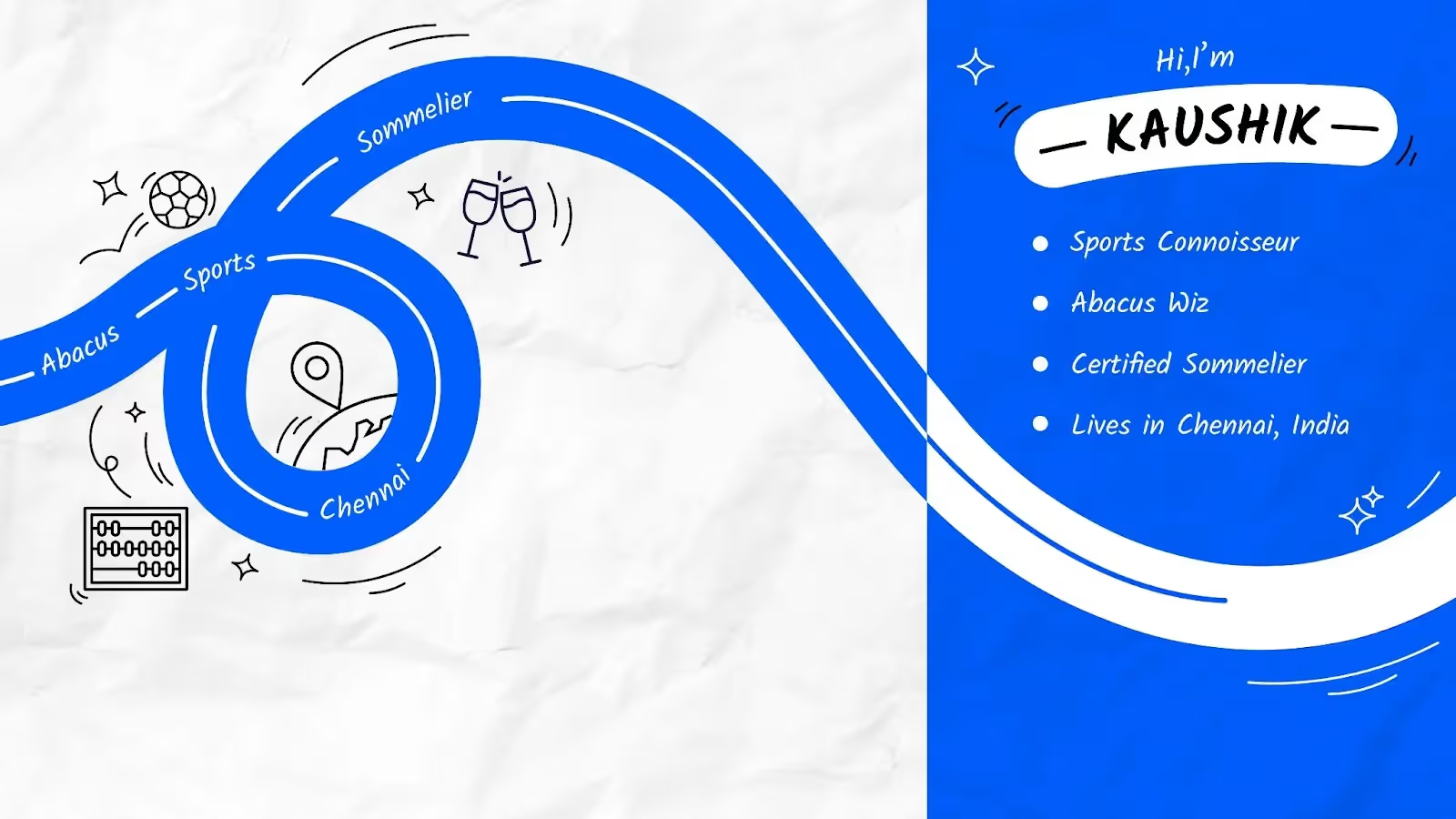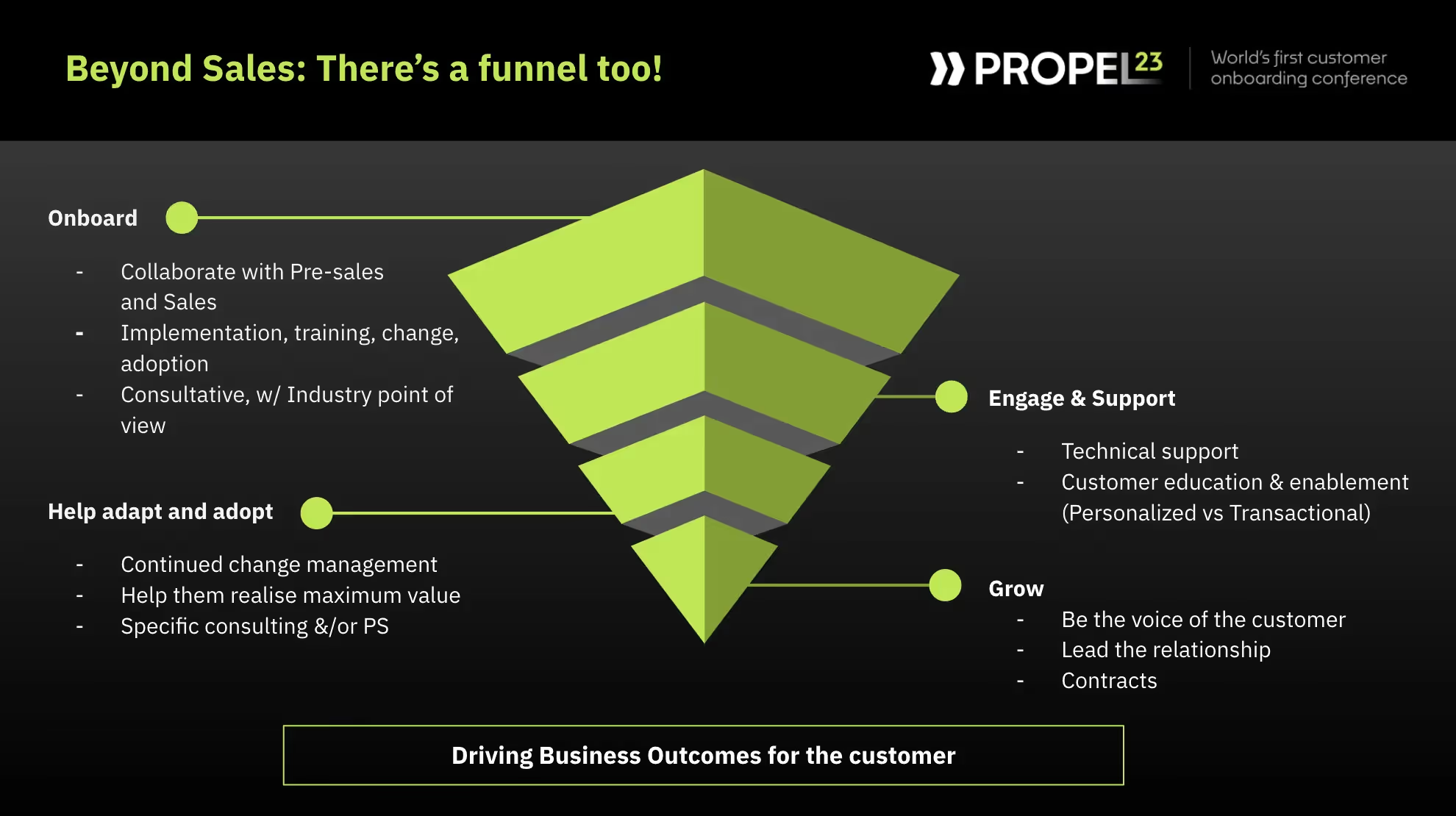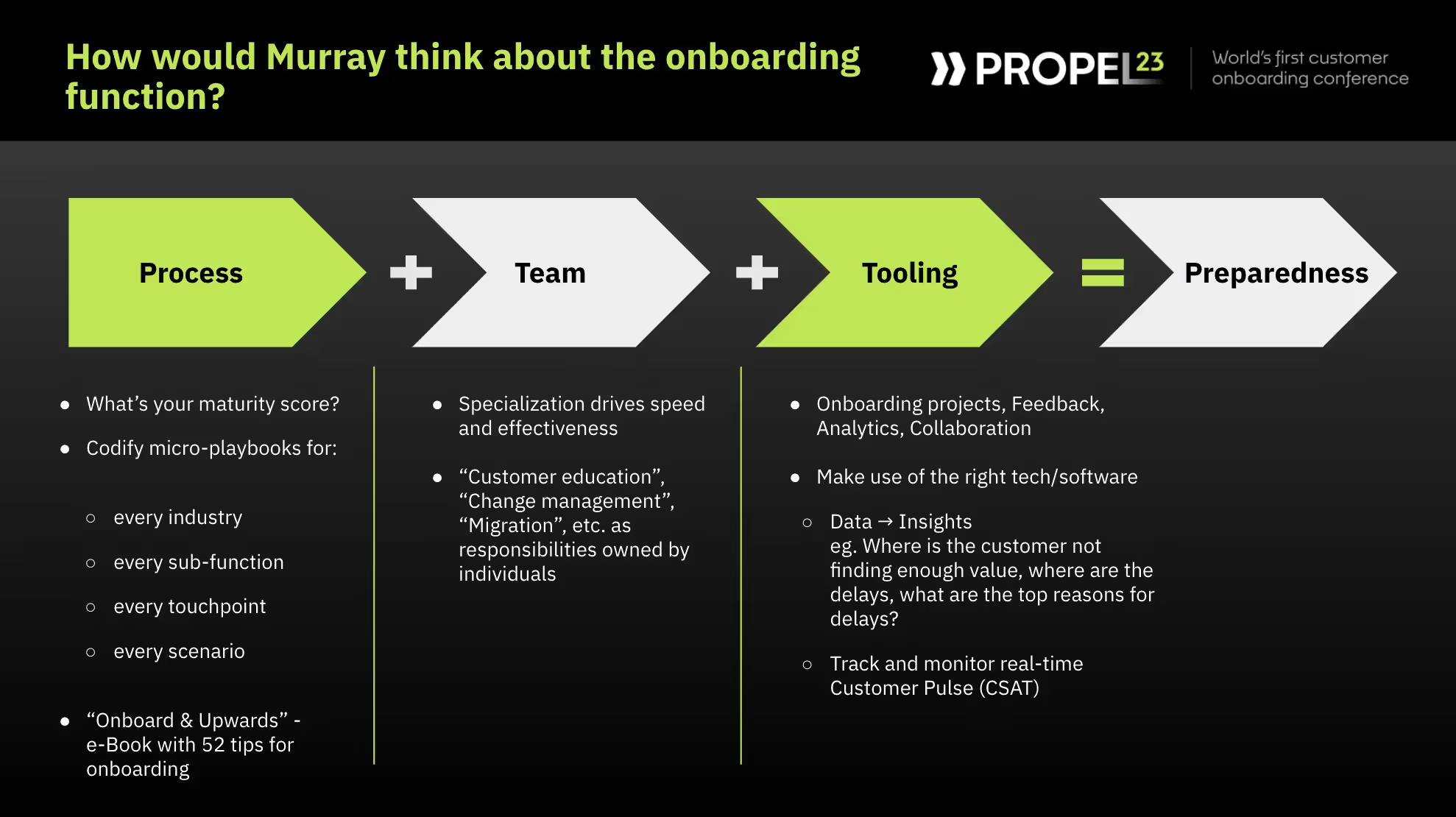Srikrishnan Ganesan is the co-founder and CEO of the leading Customer Onboarding and Professional Services Automations Platform, Rocketlane, and the #1 customer onboarding community, Preflight. He is passionate about all things CX and start-ups. Sri has spent his last decade building and scaling SaaS businesses.
In his session, Sri presented two insightful mental models for improving your customers’ post-sale experience. First, he introduced the "Airbnb Way," a creative exercise that encourages participants to craft exceptional “10-star” experiences for customers. The second model delved into taking this extraordinary 10-star experience and scaling it for industrialization with a systematic and analytical approach. This required participants to engage their analytical thinking. The overarching goal of this model, known as the "Pitstop Model," inspired by the remarkable efficiency of F1 racing, is ensuring that every customer undergoes this standardized experience.
Designing a 10-star experience
Sri began by sharing a video featuring Brian Chesky, the CEO of Airbnb, where he discussed the concept of creating 10-star guest experiences. While there is a natural inclination to consider customer experience in the realm of consumer relations, the discussion shifted towards the idea of holding customers accountable in the context of customer journeys and onboarding. This involves setting expectations and fostering engagement. The customer experience also plays a pivotal role in this dynamic, as it compels the customer to match the professional and engaging efforts demonstrated by the company.
The video is as an invitation to think beyond streamlining the onboarding process and contemplate the experiences that can instill love and trust in customers from the very beginning.
How we connect with customers at Rocketlane
At Rocketlane, we prioritize using video as a powerful tool to impress customers and create a memorable first impression. Whether it is the initial kickoff meeting or a training session with a group of users, we focus on designing an approach that makes a lasting impact.
For instance, each call at Rocketlane is initiated with a lively rap song, even while customers wait in the Zoom waiting room. This unique approach aims to ensure that meetings with customers start with the right mindset and camaraderie.
Here's Rocketlane's story in the form of a video:
Another focus area is creating more personalized connections with customers. To achieve this, every member of their customer-facing teams is provided with a customized Zoom background. This small detail allows team members to showcase their individual personalities and facilitates a deeper connection with customers during calls.

Ultimately, the objective is to be seen as more than just a vendor. Customers are encouraged to view the team as human beings with their own lives, fostering a true partnership where both parties work together towards shared success. By incorporating elements such as engaging videos, personalized backgrounds, and a mindset that values human connection, Rocketlane strives to transcend the typical "vendor-customer" relationship and build something more meaningful.
Sri then delved into the importance of kickoff meetings, a valuable opportunity for wowing customers. The focus of kickoff meetings is to set the tone for the customer onboarding journey. Rocketlane provides a comprehensive resource consisting of a one-hour video on running effective kickoff meetings on their website. In addition, there us a focus on including a few teachable moments during the kickoff. For example, there is a mention of a reverse demo where customers present how they use Rocketlane after completing training sessions. This approach encourages customers to view the Rocketlane team as knowledgeable individuals with valuable insights to offer, establishing a positive perception right at the start.
Another objective of kickoff meetings is to generate excitement about change. In cases where large teams are being onboarded, the onboarding team takes charge of change management. Customers are informed about an ‘Onboarding Day’ that will be conducted within their company. This day celebrates ongoing changes, featuring presentations of new ideas to the company's leadership. It showcases the team’s thoughtfulness in execution while teaching customers how to hold themselves and their customers accountable. Industry-specific sessions are conducted to demonstrate industry-specific validation further, eliminating any buyer's remorse or uncertainty. For example, if a salesperson talks to go-to-market teams in tech companies, a slide may feature a testimonial from a noteworthy individual in that space and logos of esteemed customers. This builds confidence in Rocketlane's expertise and assures customers that they are in capable hands.
Additionally, Rocketlane uses a unique brand of videos to share product updates. These videos are designed to be enjoyable and serve as a way to engage and test customers
Showing customers you care - the Rocketlane way
Sri highlighted another investment made at Rocketlane that contributes to building a seven-star experience: a service called Thnks. This service helps companies send small, thoughtful gifts to customers at opportune moments.
A couple of examples illustrate this approach. In one instance, the team had followed up persistently with a customer who had been avoiding them, only to discover that the customer's child was in the hospital then. Feeling remorseful, the customer success team sent the customer some cookies. The customer expressed appreciation, mentioning that it was also their birthday, and conveyed gratitude, thus transforming the partnership.
In another case, aggressive follow-up for reviews on G2 resulted in the customer being put off. Realizing the need to make amends, the team sent the customer an offer to choose a cap or hat from their preferred team. The customer noticed this gesture, which brought about a change in their sentiments towards Rocketlane.
Such acts of thoughtfulness often prompt customers to reciprocate in a similar manner. In one instance, a customer even sent the Rocketlane team coffee for a week after a delightful meeting!
How to operationalize the onboarding process at scale
With a video of a pit stop at an F1 race (one that takes just three seconds!), Sri prompted the audience to consider the precision planning, necessary tools, and practices required to execute a pit stop in under two seconds, with zero margin for error. The decision-making process includes strategy, timing, tire changes based on weather conditions, and other factors like refueling.
Sri drew a parallel between the intricacies of F1 pit stops and the complexities of the customer onboarding process. Just as a pit stop demands meticulous planning and execution, onboarding entails addressing various facets, including catering to different customer personas, managing data migration, implementing change management, and optimizing for specific business outcomes.
Beyond sales: there’s a funnel there too!

Sri highlighted the crucial role of customer onboarding within the post-sale funnel. He emphasized that if customer onboarding isn't effectively aligned with the customer's requirements, it may need executive intervention and additional resources. Failing to prioritize onboarding can impede the ability to actively engage and support customers in their journey, hindering their adoption and satisfaction.
Without a successful onboarding process, the ultimate goal of growing the customer base cannot be achieved. Therefore, ensuring that the top of the funnel, which represents onboarding, is executed well and results in a positive customer experience is crucial.
Customer onboarding the F1 way: Learnings from the F1 pit crew
Drawing parallels to the F1 pit stop model, Sri underscored the need for advanced preparation in customer onboarding. Much like a pit stop is prepared for several laps in advance, Sri emphasized the necessity of readiness in onboarding. This entails having playbooks in place, ensuring tools are optimized, and implementing a well-defined strategy well ahead of commencing onboarding activities. This highlights the importance of early preparation to guarantee a smooth and successful customer onboarding process.
F1 teams achieve rapid pit stops with a combination of the right team, specialized tools, and meticulous coordination. Each team member has a specific role in the decision-making and execution process.
Sri shared an example from McLaren, a team that faced challenges despite having exceptional drivers like Lewis Hamilton. McLaren sought the expertise of sports scientist Stafford Murray to analyze their pit stops. By observing how other teams conducted their pit stops, Murray uncovered three valuable insights.
One was that McLaren was wasting time by transporting equipment to the location where the car stopped, resulting in lost seconds. To optimize the process, McLaren adopted a new approach. They marked a designated spot for the car to stop, allowing the front jackman to begin work as the car approached. This ensured that the pit crew was already positioned and ready to go before the car arrived.
Another insight Murray discovered was related to changing tires. He found that painting the nuts in the center of the bright orange tires accelerated the tire-changing process, allowing the crew's eyes to focus on the necessary actions quickly. This enhanced efficiency and speed during pit stops.
The final lesson highlighted by Murray was that physical strength was not the sole requirement for pit crew members. Instead, they needed to be viewed as athletes playing a specific sport. Training sessions were conducted to refine their lunging techniques, determine optimal positions, facilitate effective communication, establish dominant eyes and hands, and ascertain the most effective motions. The pit crew was treated as a sports team, undergoing separate training and practice sessions prior to each season to maximize their performance.

Drawing parallels with customer onboarding, Sri reflected on the importance of process teams and tooling. In addition to assembling the right team, establishing effective team practices, and implementing the best processes, you also need to study and adapt these processes while also providing the team with the necessary tools for success.
For instance, providing relevant information during the sales process can prepare teams in advance and prevent last-minute scrambling or delays.
Check out the playbook we created! It addresses various micro situations, including buyer persona management, handling low CSAT ratings, and addressing situations where customers become unresponsive during onboarding.
Sri also discussed the idea of specialization within the onboarding team. Assigning specific team members with ownership and expertise in customer education, change management, and data migrations will be more helpful than viewing customer onboarding as a single entity. These specialists would be responsible for developing playbooks, best practices, and continuous improvements within their respective focus areas. Such ownership does not necessarily entail hiring individuals exclusively for these sub-roles. It can also be assigning responsibility and ensuring that someone is dedicated to caring for and actively addressing these areas.
Using appropriate tools for customer onboarding is also crucial. The ability to measure and track performance is essential for improvement and precision in various aspects, including project management, gathering customer feedback, and conducting training. Having specialized tools to do this can be hugely beneficial. The Rocketlane team uses Rocketlane for the onboarding process, and to measure customer satisfaction (CSAT) at every stage.
This allows for a comprehensive understanding of performance and areas of improvement.
How customer onboarding can begin before the sale
For larger deals, particularly in the mid-market and beyond, Sri recommended involving an onboarding manager. This individual joins a customer call to present the customer onboarding process, allowing them to gain firsthand knowledge of important integrations, key challenges, and objectives with the software. Discussing these factors in advance can prevent surprises during onboarding. Sri also emphasized the importance of maintaining CRM hygiene, capturing relevant information in the CRM system immediately. This eliminates the need for salespeople to rely on memory or previous interactions to pass on vital information to the onboarding team. Collaborative efforts between the sales and onboarding teams are key to deciding the information to be included in the CRM, providing context when the onboarding team begins their work.
Dealing with delinquent customers during onboarding
Sri discussed his strategy for dealing with delinquent customers during the kickoff meeting. Ideally, customers attend as scheduled, but in cases where they do not, automation and playbooks guide the process of re-engaging with the customer. Daily reminders are sent until participation is secured, demonstrating persistence.
Once the customer is present at the kickoff meeting, they are directly asked about the course of action if deadlines or responsibilities are not met moving forward. Involving an executive sponsor from the customer's side during this discussion underscores the matter's importance.
The aim is to motivate the customer's team to align and make timely progress by clarifying expectations upfront. This helps to establish accountability, enabling effective follow-up and resolution of concerns in a tangible and impactful way.
Here are more resources that Sri shared in his session:
- The State Of Customer Onboarding 2023
- What is your Customer Onboarding Maturity Score?
- How to kick ass in your kick-off meetings
- Our short fiction set in the world of customer onboarding: Onboard and Upwards






















.webp)